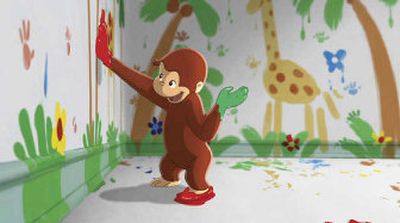This monkey took a curious path

When George, the impetuous storybook monkey famous for his curiosity, finally reaches the big screen today, there will be few outward signs that his journey into theaters has been, perhaps, his most challenging saga.
In the short, simply drawn tales that have introduced him to children for 65 years, Curious George has traveled from Africa to an American zoo, gone up in a spaceship, even signed a movie contract and played himself in a biopic.
But it’s been tough going for the little monkey in the real-life world of modern Hollywood. It’s taken 16 years, 42 writers or writing teams, nine animation studios, a bevy of directors and millions of dollars to help him make his way to the multiplex.
In fact, the attempt to turn “Curious George” into a feature-length film marks one of the longest – and possibly most exhausting – endeavors in the history of Hollywood animation.
Over the years, the “Curious George” project, developed by Ron Howard’s Imagine Entertainment and Universal Pictures, has reflected almost every trend in animation except anime. It’s been envisioned as a live action-drawn combination like “Osmosis Jones”; a live action-CG comedy like “Garfield”; and a computer-animated feature like “Toy Story.”
Abandoning animation altogether, it’s also been conceived as a live-action film with costumed actors, as in “How the Grinch Stole Christmas.”
Today, “Curious George” reflects none of those once-tempting paths. Instead, its makers say, it’s a sweet, uncomplicated children’s film whose plot unfolds in song and traditional “2-D” drawn animation – a rarity in computer-happy Hollywood.
Perhaps unavoidably, after kicking around Hollywood for so long, this George has had a little work done – he now has eyeballs, for instance.
But studio officials say the new-look character will be more accessible to children, while not losing his appeal to the parents and grandparents who grew up reading their young ones the classic stories of H.A. and Margret Rey.
The Curious George books are all variations on one basic scenario: George’s inquisitive nature leads him into trouble. His friend, the Man in the Yellow Hat, helps him get out of it. The end. No lessons, no real character development, just a relationship that George, and his readers, can count on.
But once you try to take him off the page, a couple of potential problems come into bold relief: George doesn’t speak, so other characters have to do it for him by reacting to his antics. And his stories, in the parlance, have no arc.
Legions of imaginations over the years struggled to make a movie that could blossom within those constraints. According to the Writers Guild of America, West, the list includes Brad Bird (“The Incredibles”), William Goldman (“The Princess Bride”), Pat Proft (“Police Academy”), Babaloo Mandel and Lowell Ganz (“A League of Their Own”), Joe Stillman (the two “Shrek” features), and Daniel Gerson and Rob Baird (“Monsters, Inc.”).
“I don’t think all of us wanted to go through all the writers we did,” says David Kirschner, one of the producers on the film.
“Pat Proft did a (live-action) draft on this that had a lot of really funny, funny stuff, but in the end, what we really wanted was the special relationship between this man and this little monkey,” Kirschner says. “As simple as those pages are, and they look like a rather short children’s book, it was really difficult to capture the innocence of that.”
David Brewster, who joined the production in the fall of 2003 as animation supervisor, recalls that “something like 16 writers” went through while he was there “and I don’t know how many storyboard artists.”
After more than a year of working on a script commissioned from Goldman under then-director Jun Falkenstein, Brewster says Imagine and the studio fired the director and brought in Matthew O’Callaghan, who completely revamped the story, bringing it back to its original source material.
The final script contains certain iconic moments from the books that people remember: George flying away with a bunch of balloons, George flying a kite, George painting the interior of an apartment to make it look like a jungle, George getting into a rocket ship, George at the zoo.
Will Ferrell was brought on board as the voice of the Man in the Yellow Hat – now called “Ted” – who takes George from his native jungle to the big city.
With that kind of star power, O’Callaghan says, he realized that they couldn’t just “bookend” the movie with the character’s appearances, as it is done in some of the books.
“You couldn’t introduce his character at the beginning of a 70-minute movie, let George run the course of the whole movie, and then again bring in Will Ferrell. So what I think we wanted to do was make kind of a buddy movie.”
The studio filled out the cast with voice talent including Drew Barrymore, Eugene Levy, Dick Van Dyke and Joan Plowright – and, in a move it views as a real coup, hired Hawaii-born musician and surfer Jack Johnson to supply original songs.
Kathy Nelson, president of film music at Universal Pictures, says she learned that Johnson, who recently scored Grammy nominations for pop singing and for his work with the Black Eyed Peas, was “obsessed by Curious George.”
Johnson wrote 13 songs for the soundtrack album, nine of which are included in the film.
“Music is so important to the movie,” Nelson says. “Our main character doesn’t speak. He makes little noises. He squeaks …
“Since George doesn’t speak, Jack decided he wanted to be the voice of George. So his songs provide the narrative.”